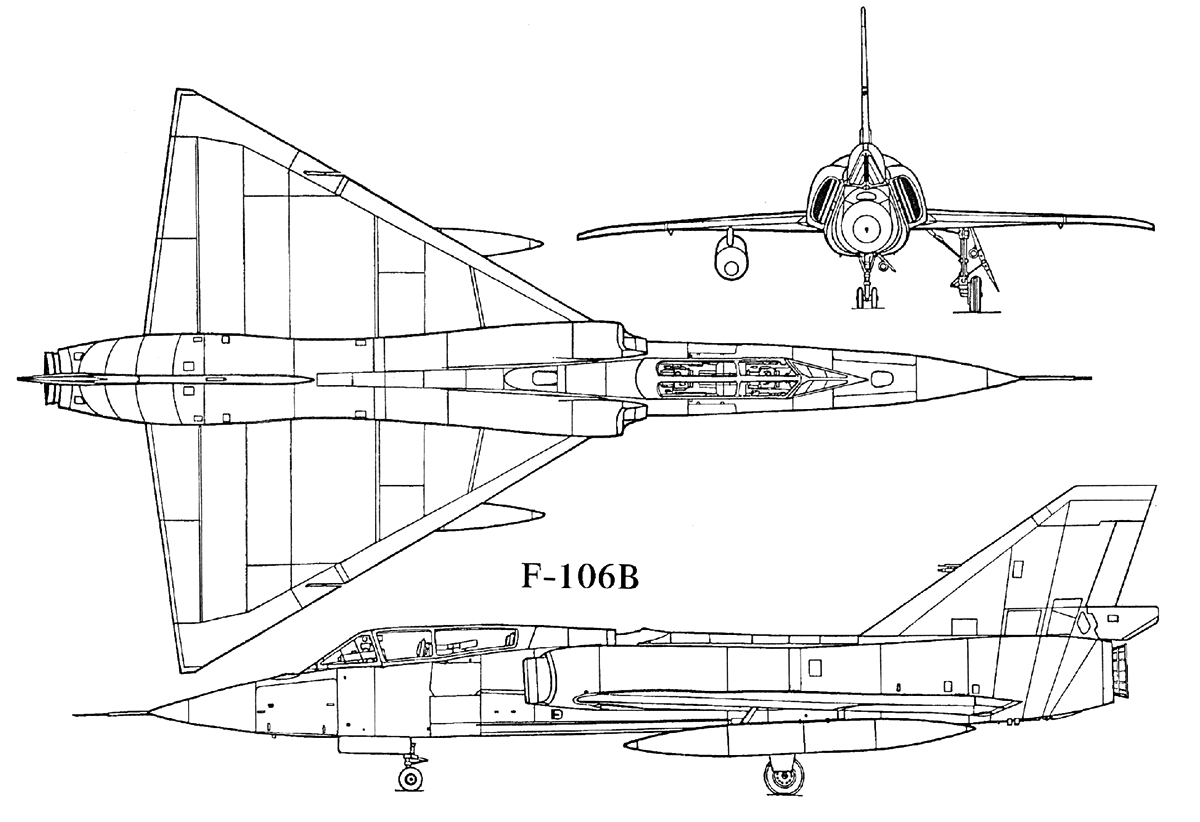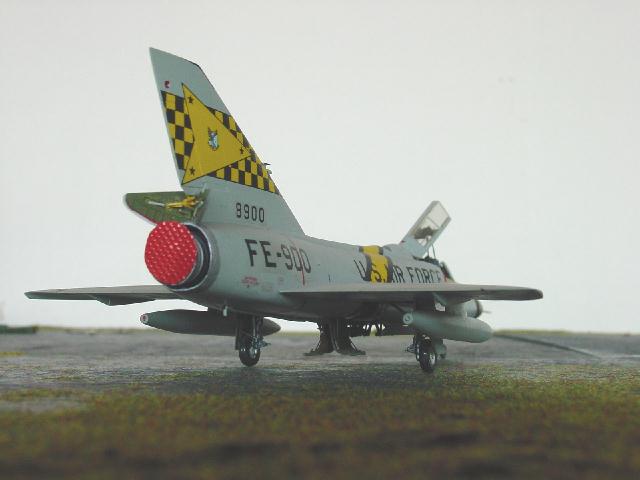Heres an interesting one that somehow isnt in the request pages..
All info from this website:
http://www.airvectors.net/avf102.htmlCONVAIR (GENERAL DYNAMICS) F-106A DELTA DART:
_____________________ _________________ _______________________
spec metric english
_____________________ _________________ _______________________
wingspan 11.67 meters 38 feet 4 inches
wing area 64.83 sq_meters 698 sq_feet
length 21.55 meters 70 feet 8 inches
height 6.18 meters 20 feet 4 inches
empty weight 10,800 kilograms 23,815 pounds
MTO weight 17,350 kilograms 38,250 pounds
max speed at altitude 2,395 KPH 1,490 MPH / 1,295 KT
service ceiling 17,680 meters 58,000 feet
range with tanks 3,140 kilometers 1,950 MI / 1,695 NMI
The F-106A used a bigger and badder derivative of the J57, the "J75", fed by new variable-ramp air intakes,
with the more powerful engine providing a significant boost in performance. On 15 December 1959, USAF
Major Joseph Rogers obtained a world speed record of 2,456.78 KPH (1,525.95 MPH) with the F-106A, and it
is said that this remains the fastest flight ever of a single-engine jet aircraft.
The production F-106A "Delta Dart" reached initial operating capability with the ADC in October 1959, with
the type becoming known as the "Six" to crews. A total of 277 F-106As was built, plus 63 "F-106B" tandem-seat
operational conversion trainers, for a total of 340 in all. The USAF / USANG was the only operator.
* A general description of the F-106A almost exactly matches that of the F-102A. Like the Deuce, the Six
was a delta-winged machine with a tailfin but no tailplanes, featuring tricycle landing gear and a clamshell
canopy that hinged open to the rear. Early wings had fences; later production featured slots instead.
It was armed with four Falcon AAMs, plus a single MB-1 (later AIR-2) Genie unguided nuclear AAM, all in belly
weapons bays, and originally had no cannon. The only external stores were an external fuel tank under each
wing. The Six even retained the unusual tailfin airbrake (with drag chute) introduced on the F-102.
The Six was otherwise hardly a copy of the Deuce, with many refinements and detail differences -- in fact the
percentage of parts common between the F-102 and F-106 was low. Of course there was the more powerful P&W
J75 engine; the definitive J75-P-17 powerplant delivered 76.5 kN (7,800 kgp / 17,200 lbf) dry thrust and 109 kN
(11,110 kgp / 24,500 lbf) afterburning thrust. The F-106A's fuselage was much more aerodynamically refined, in
particular eliminating the tack-on fairings along the tail, and the improved MA-1 FCS provided SAGE compatibility
from the outset. The steerable nosewheel had two wheels instead of one, and the external tanks were larger, each
with a capacity of 1,364 liters (360 US gallons), as well as a streamlined configuration to permit supersonic carriage.
A socket for midair boom refueling was added from 1967 as an upgrade.
The pilot sat on a Convair-designed ICESC (Industry Crew Escape System Committee) supersonic ejection seat,
though it proved unsatisfactory, with some ejections resulting in fatalities. It was replaced by a Weber rocket-boosted
"zero zero" (zero speed zero altitude) seat from 1964. The Weber seat was not supersonic capable, but analysis of
accidents showed that supersonic ejections almost never took place anyway -- usually when something went wrong
in supersonic flight, the aircraft went subsonic immediately, or the anomaly was so disastrous that the pilot never
had a chance to get out. The biggest hazards were actually in takeoffs and landings.
Upgrades were performed on a regular basis. Early upgrades were generally to fix aircraft teething problems,
leading to additions such as a clear-view canopy; an airfield arresting hook; improved variable engine inlet ramps;
retractable IRST unit, "tape"-style dashboard indicators that were easier to read than the original dial indicators;
radar warning receiver; and improved solid-state electronics. From 1967, F-106As were fitted with the General
Electric M61A Vulcan 20 millimeter six-barreled Gatling-type cannon and gunsight under Project SIX SHOOTER, the
notion of arming an aircraft solely with AAMs having proven a little too ahead of its time. The cannon had an
ammunition supply of 650 rounds and replaced the Genie AAM; arming the F-106 with a nuclear weapon proved
troublesome because of the enhanced security and administration required. The F-106B received most of the
upgrades as well, though no two-seater ever had the Vulcan cannon.
The Six was greatly admired by both service and aircrews alike, and in fact one of the reasons that the F-102
tends to be slighted in sources is because the F-106 was such a vast improvement on it. The F-106 was reliable,
easy to maintain, and had outstanding performance. Although delta winged aircraft tend to have long takeoff runs
because they can't usually be fitted with flaps, are hot on landing, and lose speed badly in turns, the F-106 had good
handling and was said to be surprisingly agile, its high power-to-weight ratio allowing it to overcome a delta's limits
on maneuverability. It had few "funnies" and gave plenty of stall warning. It was phased out of ADC service in the early
1980s, to serve with the Air National Guard until 1988.
Some sources claim the Dart was used for "dissimilar air combat training (DACT)" as an "aggressor" for some years because
its performance was similar to that of a Soviet Mikoyan MiG-21 fighter. It appears that it was never actually used as a
full-time aggressor, but participated in a number of COLLEGE DART exercises during the 1970s that involved DACT.
There was some effort to sell the Six to the US Navy for DACT and models were made of the F-106A in disruptive desert
camouflage for the role, but it didn't happen. Almost 200 Darts were converted into high-speed target drones under the
PACER SIX program, with the "QF-106" targets serving into 1997.
* There were no foreign operators of the F-106.
* Convair considered development of an improved "F-106C" (along with an "F-106D" two-seater) with a longer
nose and more powerful radar. two F-106As were modified to test F-106C radar, being designated "YF-106C",
though it appears only one flew before the program was canceled.
* Convair also considered a bewildering range of F-106 follow-ons, the most ambitious featuring twin General Electric
J93 turbojets, as used on the North American XB-70 Valkyrie experimental bomber, which would have given the F-106
Mach 3 performance. There was also consideration of an "Advanced F-106" with a single engine, either a J75 derivative
or alternative powerplant, featuring canard fins, with both land-based and carrier-based versions considered, the
carrier-based version having folding wings.








showing the position of airbrake and drag chute

I very humbly mention this aircraft because: as America's primary home defense/interceptor of its day... we will need it if any of the more advanced Soviet fighters begin appearing in IL-2, such as the Flogger/Foxbat.

fresco
 Author
Topic: Convair F-106 Delta Dart (Read 11074 times)
Author
Topic: Convair F-106 Delta Dart (Read 11074 times)


